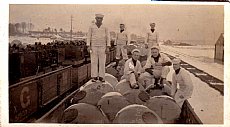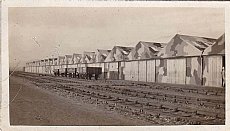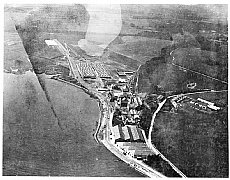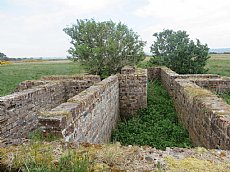Wartime Dalmore
Dalmore Distillery, located between Invergordon and Alness, was founded in 1839. Over the years it grew, and by 1914 included a number of warehouses and other buildings. In 2019 a group met weekly at Invergordon Museum to research activity at the distillery in World War I and World War II.
Dalmore in WWI – A U.S. Navy base

courtesy Invergordon Museum
Towards the end of WWI, the U.S. Navy became involved in assembling mines and then deploying them between Orkney and Norway (the so-called Northern Barrage). In the Highlands two sites were taken over for this purpose: at Glen Albyn distillery in Inverness, where the mines and supplies were transported through the Caledonian Canal (Base 18), and at Dalmore, with materials arriving from Kyle of Lochalsh and then via the railway to Dalmore (Base 17). Grangemouth in the Central Belt was also used.

Wayne O. Abbott Collection
courtesy Invergordon Museum
Base 18 in Inverness has been the subject of research by Inverness Local History Forum, but the Dalmore site has had little attention focussed on it, despite being the best preserved of the three U.S. Navy sites. The requisition of the distillery required the removal of gallons of whisky, and then the building of hangars, sheds, a new pier, accommodation, extensive railway sidings, and a new branch line to Invergordon to allow for the mines to be shipped off for laying between Orkney and Norway). This is an important and little-known aspect of the war, with a large impact in the Highlands.
 There is a surprising amount of material available. The National Archives contain Admiralty documents and plans detailing negotiations and planning for the U.S. arrival. The Imperial War Museum has some photos as well taken by the Captain in charge of Inverness Base 18, which includes a few relating to Base 17. A military document dating to 1920 describing the two bases, with an annotated plan, was found in Alness Library. This shows three large warehouses to the field to the west of the distillery, linked by numerous railway sidings. It also shows new buildings, including a U.S. YMCA and a generating building.
There is a surprising amount of material available. The National Archives contain Admiralty documents and plans detailing negotiations and planning for the U.S. arrival. The Imperial War Museum has some photos as well taken by the Captain in charge of Inverness Base 18, which includes a few relating to Base 17. A military document dating to 1920 describing the two bases, with an annotated plan, was found in Alness Library. This shows three large warehouses to the field to the west of the distillery, linked by numerous railway sidings. It also shows new buildings, including a U.S. YMCA and a generating building.

A United States Atlantic Fleet.
The North Sea 1918.
There are also archive documents and photos on the U.S. Navy archive website, giving the U.S. viewpoint during the planning stage and many useful photos. In addition, four books by the U.S. Navy were published just after WWI. One, by sailors and others who had served in the Highlands, includes cartoons, photos, and even a theme song with music. The four books are still in print, and copies can be consulted at Invergordon Museum.
Of immense value was a set of images donated to Invergordon Museum in 2018 by the grandson of a U.S. sailor, Wayne O. Abbott, who served mainly at Base 17. Most are annotated and provide important information about Base 17.
 There is also a rare aerial photograph of the distillery and fields to the west taken from an airship. Clearly authorities feared an aerial attack even at this early date, as photos show many of the buildings with camouflage paint.
There is also a rare aerial photograph of the distillery and fields to the west taken from an airship. Clearly authorities feared an aerial attack even at this early date, as photos show many of the buildings with camouflage paint.
All of these sources show a major undertaking, with over 1000 men stationed at the base from spring 1918. Mines components arrived by train, were stored and assembled in the large warehouses. When ready, they were shipped by rail to Invergordon on newly constructed line along the shore, for loading onto ships to be sent to the North Sea. Over 38,000 mines were produced and dispatched in the months until the Armistice.
After the Armistice, the real problem began of retrieving the mines which had been laid. Unused mines from Base 17 were shipped back to the U.S. In March 1919 the facilities were handed over to the U.K. Admiralty, and the U.S. mine retrieving operation moved to Kirkwall. After 1924 the site was returned to Dalmore distillery. A long pier, now known as the Yankee pier, begun in 1918 but finished after the war ended, had been intended to allow deployment from Dalmore. Instead it was used by the Admiralty after the war for its own mine retrievals.
Newspaper accounts and town and regional council documents provide insights into the logistics of supplying this large undertaking with water and roads, with much wrangling between military and local government. The social impact of a number of American servicemen had a major impact on the area too, reflected in published memories, newspaper accounts and other sources. Some family history searches were carried out revealing a few marriages between local girls and U.S. sailors.
 While most of the buildings and railways sidings were removed directly after the war, for some reason the detonator store, located in railway sidings, was left, a rare survival of a WWI building. Some of the foundations of the large warehouses can still be traced as well. Members of the group also found a few sections of rails to the east of Dalmore near Bellaport, on the route where the branch line joined the mainline.
While most of the buildings and railways sidings were removed directly after the war, for some reason the detonator store, located in railway sidings, was left, a rare survival of a WWI building. Some of the foundations of the large warehouses can still be traced as well. Members of the group also found a few sections of rails to the east of Dalmore near Bellaport, on the route where the branch line joined the mainline.
Dalmore in WWII – A RAF Technical Area
In World War II the distillery was again taken over by the military as an RAF training and repair base for flying boats. This was built when the operations outgrew space available in Invergordon in 1941 and 1942. A number of buildings were constructed, some of which remain today on the site. This was one of a number of RAF sites, large and small, in the Alness area.
Fortunately a detailed plan survives, now held in the RAF Museum. Its detailed key shows that buildings on the site included accommodation, administrative and training offices, radar installation, a photographic unit, enormous fuel tanks, bomb and other weapon stores, and maintenance facilities. Unlike in WWI, the distillery buildings were not taken over. At first called RAF Invergordon, it was renamed RAF Alness in 1943.
 An aerial photo from the end of the war shows that most buildings were nissen huts. It also shows a number of blast shelters scattered throughout the site. A surprising number of building remains survive. Most blast shelters are still intact. A few Nissen huts in ruinous condition are on the field. Foundations of most of the other buildings can still be traced unless they have been built over by post-WWII distillery buildings.
An aerial photo from the end of the war shows that most buildings were nissen huts. It also shows a number of blast shelters scattered throughout the site. A surprising number of building remains survive. Most blast shelters are still intact. A few Nissen huts in ruinous condition are on the field. Foundations of most of the other buildings can still be traced unless they have been built over by post-WWII distillery buildings.
A number of memories survive from men and women who worked in the technical area. WAAFs remember reversing down the long Yankee pier to pick up crews to transport them to Invergordon, bringing blankets to warm the frozen crew. Many personnel in the area recall the need for bicycles to get between all the sites and to Invergordon.
The group created an exhibition on wartime Dalmore which will be housed at Invergordon Museum when it is not travelling. Contact the museum if you are coming specially to see it. Various resource material is also kept at the museum, and binders of information are alsobeing deposited in Alness and Invergordon Libraries and Alness Heritage Centre.
The project was funded by the Port of Cromarty Firth and Orion Group, with additional support from ARCH, Invergordon Museum and Alness Heritage Centre.

Further Information
WWI:
U.K. Military documents and pictures
Minelaying bases at Grangemouth, Dalmore and Glen-Albyn, published 1920, The Technical history and Index C.B. 1515 (45). Copy available in Alness Library and Invergordon Museum
Archives in National Archive:
ADM 137/847
ADM 137/848
ADM 137/864
U.S. Military documents and pictures
‘All Hands’ (ed). 1919. The Northern Barrage. Mine Force. A United States Atlantic Fleet. The North Sea 1918.
Belknap, Reginald R. 1920. The Yankee Mining Squadron or Laying the North Sea Mine Barrage
Daniels, Josephius (ed.) 1920. Taking up the Mines. (Publication no. 4)
Daniels, Josephius (ed.) 1920. The Northern Barrage and other Mining Activities (Publication no. 2)
https://www.history.navy.mil/content/history/nhhc/our-collections/photography.html
Invergordon Museum
Wayne O. Abbott collection
Other useful information
Pratt, Edwin A. 1921. British Railways and the Great War. Organisation, efforts, difficulties and achievements. Useful for railway history. Available on line.
WWII
Alness Heritage Centre has a number of files, photographs and memories, particularly for WWII. Some of these are produced in Alness at War, published by Alness Heritage Centre.
Hughes, Jim 1999 (rev. ed.). A Steep Turn to the Stars.
Hughes, Jim 1999. Airfield Focus 31. Invergordon.
The National Archives have Operational Record Books, Daily Routine Orders and other archives. Operations Record Book AIR 29/609 is particularly useful for Dalmore development.
The RAF Museum has a map of the base in WWII, together with photographs, most post-war in date.
Latest News...
12/08/2025 - ARCH August 2025 Newsletter now available
The August 2025 ARCH newsletter is now available to download from the Library. It contains... More >>
30/03/2025 - Dingwall Station Online display
The latest online display available on the website is Dingwall Station, originally made du... More >>
27/02/2025 - ARCH February 2025 Newsletter now available
The February 2025 ARCH Newsletter is now available to download from the Library on the ARC... More >>
Site of the Month
 10/04/2021 - Easter Raitts township
10/04/2021 - Easter Raitts township
Easter Raitts township Photo: Highland HER Although the Highlands is dotted with de... More >>
Find of the Month
These stone vessels, many with handles, were found at a variety of sites in Sutherland and... More >>



 25/07/2022 - Steatite Vessels
25/07/2022 - Steatite Vessels